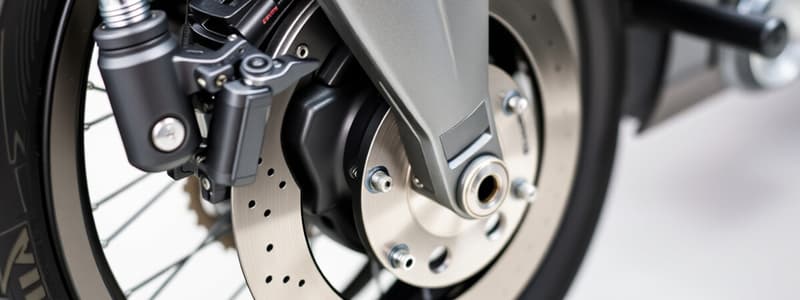Podcast
Questions and Answers
What mechanism is used in air-operated disc brakes to create clamping pressure on the disc?
What mechanism is used in air-operated disc brakes to create clamping pressure on the disc?
- Hydraulic Cylinder
- Piston Mechanism
- S-cam system
- Power Screw (correct)
What is the required action before the low air pressure warning signal activates?
What is the required action before the low air pressure warning signal activates?
- Pressure in air tanks falls below 60 psi (correct)
- Pressure in air tanks falls below 40 psi
- Pressure in air tanks falls below 80 psi
- Pressure in air tanks rises above 60 psi
How are the emergency and parking brakes on vehicles held in place?
How are the emergency and parking brakes on vehicles held in place?
- By electrical energy
- By hydraulic force
- By pneumatic controls
- By mechanical force (correct)
What happens to the spring brakes if air pressure is lost during driving?
What happens to the spring brakes if air pressure is lost during driving?
How do vehicles notify drivers behind them that the brakes are being applied?
How do vehicles notify drivers behind them that the brakes are being applied?
What is typically used to adjust the parking brake in most vehicles?
What is typically used to adjust the parking brake in most vehicles?
In a dual air brake system, how is air pressure monitored?
In a dual air brake system, how is air pressure monitored?
What is the primary function of the supply pressure gauge in an air-brake system?
What is the primary function of the supply pressure gauge in an air-brake system?
What is the primary role of the differential in the rear axle system?
What is the primary role of the differential in the rear axle system?
When should the locking differential be engaged for optimal performance?
When should the locking differential be engaged for optimal performance?
Which statement best describes the function of the Inter-Axle Differential Lock (IAD)?
Which statement best describes the function of the Inter-Axle Differential Lock (IAD)?
What must be avoided when using the IAD lock with rear wheels spinning?
What must be avoided when using the IAD lock with rear wheels spinning?
What distinguishes a standard transmission from an automatic transmission?
What distinguishes a standard transmission from an automatic transmission?
What is required for wheels and tires in terms of weight management?
What is required for wheels and tires in terms of weight management?
What is the primary function of the electrical system in a vehicle?
What is the primary function of the electrical system in a vehicle?
Which of the following is NOT a component of the steering system?
Which of the following is NOT a component of the steering system?
What happens when a vehicle drives on dry pavement with the locking differential engaged?
What happens when a vehicle drives on dry pavement with the locking differential engaged?
What is the purpose of the suspension system in a vehicle?
What is the purpose of the suspension system in a vehicle?
What is the minimum recommended tread depth specifically for emergency vehicles?
What is the minimum recommended tread depth specifically for emergency vehicles?
Which inspection category includes checking the cleanliness and body damage of the vehicle?
Which inspection category includes checking the cleanliness and body damage of the vehicle?
Automatic traction control primarily assists in maintaining traction by doing what?
Automatic traction control primarily assists in maintaining traction by doing what?
What should be the driver’s first action before conducting an interior cab inspection?
What should be the driver’s first action before conducting an interior cab inspection?
Which fluid levels are checked during the engine compartment inspection?
Which fluid levels are checked during the engine compartment inspection?
What must the driver confirm about the vehicle before it is deemed ready for use?
What must the driver confirm about the vehicle before it is deemed ready for use?
When traction is lost and automatic traction control is limiting acceleration, what should the driver do?
When traction is lost and automatic traction control is limiting acceleration, what should the driver do?
During the preventive maintenance inspection process, which step involves reviewing past defects?
During the preventive maintenance inspection process, which step involves reviewing past defects?
Which of the following checks is crucial for assessing potential leaks in the vehicle?
Which of the following checks is crucial for assessing potential leaks in the vehicle?
What is a primary responsibility of the driver regarding vehicle maintenance?
What is a primary responsibility of the driver regarding vehicle maintenance?
What function does the hydraulic type of driveline retarder serve?
What function does the hydraulic type of driveline retarder serve?
Why should the retarder be turned off during inclement weather?
Why should the retarder be turned off during inclement weather?
What is the main purpose of Diesel Exhaust Fluid (DEF) in post-2009 diesel vehicles?
What is the main purpose of Diesel Exhaust Fluid (DEF) in post-2009 diesel vehicles?
What should be avoided to prevent crystallization of Diesel Exhaust Fluid (DEF)?
What should be avoided to prevent crystallization of Diesel Exhaust Fluid (DEF)?
What happens when the Diesel Exhaust Fluid (DEF) tank reaches empty?
What happens when the Diesel Exhaust Fluid (DEF) tank reaches empty?
What is the primary concern associated with a faulty exhaust system?
What is the primary concern associated with a faulty exhaust system?
How does the Diesel Particulate Filter (DPF) indicate when regeneration is necessary?
How does the Diesel Particulate Filter (DPF) indicate when regeneration is necessary?
What is the typical freezing point of Diesel Exhaust Fluid (DEF)?
What is the typical freezing point of Diesel Exhaust Fluid (DEF)?
Which component of the driveline is NOT directly involved in the function of the retarder?
Which component of the driveline is NOT directly involved in the function of the retarder?
What material is used in Diesel Exhaust Fluid (DEF)?
What material is used in Diesel Exhaust Fluid (DEF)?
What is the minimum tread depth required on non-steering axles?
What is the minimum tread depth required on non-steering axles?
Which system should be checked to ensure the vehicle can maintain electrical systems at fast idle RPMs?
Which system should be checked to ensure the vehicle can maintain electrical systems at fast idle RPMs?
During a vehicle walk around, which of the following should be checked specifically for potential vision obstruction?
During a vehicle walk around, which of the following should be checked specifically for potential vision obstruction?
Which part should not have excessive movement more than 1 inch and should be checked during a brake system inspection?
Which part should not have excessive movement more than 1 inch and should be checked during a brake system inspection?
What must be checked for any obvious fluid leaks during an undercarriage inspection?
What must be checked for any obvious fluid leaks during an undercarriage inspection?
Which warning devices are required to be on board as part of DOT regulations?
Which warning devices are required to be on board as part of DOT regulations?
What condition indicates the need for bleeding moisture from the air tanks?
What condition indicates the need for bleeding moisture from the air tanks?
What should be checked on tires in addition to inflation and tread depth?
What should be checked on tires in addition to inflation and tread depth?
Which of the following is not a component to check in the interior lighting system?
Which of the following is not a component to check in the interior lighting system?
Which document is not typically checked during a vehicle inspection?
Which document is not typically checked during a vehicle inspection?
What is the primary function of the Antilock Braking System (ABS)?
What is the primary function of the Antilock Braking System (ABS)?
In a dual air brake system, what does the primary system typically operate?
In a dual air brake system, what does the primary system typically operate?
Which type of auxiliary brake is also known as a compression brake?
Which type of auxiliary brake is also known as a compression brake?
What is the purpose of the driveline brake in a parking brake system?
What is the purpose of the driveline brake in a parking brake system?
Why is it advised not to push the brake pedal down when the spring brakes are on?
Why is it advised not to push the brake pedal down when the spring brakes are on?
Which component is part of the automatic transmission retarder system?
Which component is part of the automatic transmission retarder system?
When is the engine brake typically not effective on vehicles with automatic transmission?
When is the engine brake typically not effective on vehicles with automatic transmission?
What happens when the ABS senses that a wheel is about to lock up?
What happens when the ABS senses that a wheel is about to lock up?
What condition should the engine brake's mode be set during inclement weather?
What condition should the engine brake's mode be set during inclement weather?
How many separate air brake systems are typically found in a dual air brake system?
How many separate air brake systems are typically found in a dual air brake system?
Flashcards are hidden until you start studying
Study Notes
Disc Brakes
- Air-operated disc brakes utilize air pressure to actuate a power screw, pressing a caliper against brake lining pads, functioning like a large C-clamp.
- The system includes slack adjusters akin to S-cam brakes.
Air Brake System Components
- Supply Pressure Gauge: Displays pressure in tanks; dual systems have separate gauges or a dual needle gauge.
- Low Air Pressure Warning: Activates a visible signal (usually a red light) before pressure drops below 60 psi.
- Brake Light Switch: Turns on brake lights automatically upon brake application, activated by air pressure.
Spring Brakes
- Essential for emergency and parking; they apply automatically when air pressure is lost.
- Engaged by mechanical force, preventing reliance on air pressure alone.
Parking Brake Controls
- Typically a yellow, diamond-shaped knob used to engage or release spring brakes.
- Best practice avoids pressing the brake pedal when spring brakes are engaged to prevent damage.
Dual Air Brake System
- Consists of two separate systems (primary for rear and secondary for front axles) enhancing safety.
- Common in newer vehicles for redundancy; allows for continued braking even if one system fails.
Antilock Braking Systems (ABS)
- Prevents wheel lock-up during braking, maintaining steering control and stability.
- Sensors detect wheel speed; the system automatically "pumps" brakes to prevent wheels from locking.
Auxiliary Braking Systems
- Engine Brake: Also known as compression brake; utilizes engine compression to slow the vehicle.
- Automatic Transmission Retarder: Attached to the transmission, it uses pressurized fluid interaction to decelerate the vehicle.
- Driveline Retarder: Can be hydraulic or electromagnetic, absorbing energy to slow the vehicle.
Exhaust Systems
- Modern diesel engines are fitted with "aftertreatment" systems that include Diesel Exhaust Fluid (DEF) and Diesel Particulate Filter (DPF).
- DEF reduces nitrogen oxide emissions; it's stored separately and should be replenished before empty to avoid power reduction.
Driveline Components
- Comprises transmission, driveshafts, and differential, allowing for varying wheel speed during turns.
- Locking differential ensures equal torque distribution to wheels; should only engage below 25 mph.
Steering System
- Steering is controlled through a mechanism connecting the steering wheel and column to front wheels, often enhanced with power assist for easier maneuverability.
Electrical Systems
- Powers essential vehicle functions like lights, horn, siren, and public address systems as well as the primary electrical components.
Suspension System
- Includes leaf springs, shock absorbers, and tire systems to maintain vehicle control over rough terrain.
Wheels and Tires
- Must meet weight ratings and display proper inflation and tread conditions; minimum recommended tread depth for emergency vehicles is 4/32 inches.
- Automatic traction control systems aid tire traction by selectively applying brakes to spinning wheels.
Preventive Inspections for Emergency Vehicles
- Regular inspections are vital to maintain vehicle readiness and prevent accidents caused by mechanical failures.
- Inspections cover nine core areas, including maintenance records, engine checks, interior controls, walk-around assessments, and emergency systems.
Inspection Categories Explained
- Check PM Records: Review previous maintenance logs for issues.
- Vehicle Overview: Assess for damage and cleanliness; check for vehicle leveling.
- Engine Compartment Check: Verify oil, fluid, and battery levels; inspect belts and seals.
- Interior Cab Check: Test instrumentation, brake functionality, steering, and communication systems.
- Vehicle Walk Around: Inspect tires, lights, and external features for operational integrity.
- Undercarriage Check: Assess condition of the underside, including brake lines.
Overall Vehicle Safety Responsibility
- The driver is responsible for mechanical safety and must ensure the vehicle is fit for duty; "if it isn't right, do not drive it."### Tread Depth Requirements
- Steering axles require a minimum tread depth of 4/32”.
- Non-steering axles require a minimum tread depth of 2/32”.
Snow Chains and Fluid Leaks
- Automatic snow chains must be assessed for condition, positioning, and operational status.
- Check undercarriage and ground for fluid leaks, noting the fluid's color for diagnosis.
Compartment and Equipment Checks
- Ensure compartment latching mechanisms function correctly.
- Verify portable power equipment is operational and adequately fueled.
- Confirm inventory is complete and items are stored in designated locations.
- Inspect circuit breakers on onboard generators for functionality.
- Check that DOT-required traffic warning devices (cones, flares, reflective triangles) are present.
- Ensure at least one dry chemical fire extinguisher is available and fully charged.
Crew Equipment Verification
- Basic crew equipment should include SCBA, handheld lights, AED, and EMS supplies.
- All crew equipment must be checked for operational integrity.
- Additional equipment, such as haz-mat lights, should also be functioning properly.
Undercarriage Inspection
- Regularly bleed moisture from air tanks to prevent damage.
- Light gray sludge in fluids indicates compressor issues.
- Brake lines should be examined for cracks, fraying, dry rot, or excessive wear.
- Slack adjusters should show no more than 1 inch of excessive movement; adjustments should not be attempted without trained personnel.
- Ensure proper greasing of the driveline; check joints for excessive movement and intact dust covers.
- Inspect the exhaust system for soot stains that may indicate leaks, as well as checking clamps.
Studying That Suits You
Use AI to generate personalized quizzes and flashcards to suit your learning preferences.




